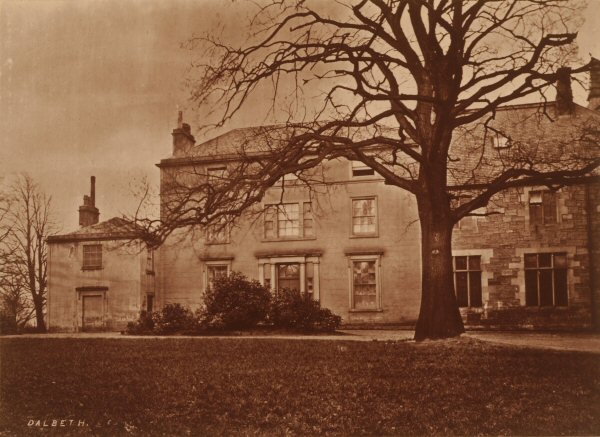

THE property now known exclusively by the name of Dalbeth is a comparatively small portion of a large range of lands anciently bearing that general appellation, situated on the right bank of the Clyde, about three miles eastward from Glasgow, on the line of "the London Road." (1) This extensive tract reached from Dalmarnock, eastward to, and including what is now called Easterhill. Dalbeth was divided into Wester and Easter, and these again were subdivided into farms with subsidiary appellations, such as "The Newlands of Dalbeth," "Little Newlands," "Westthorn," "Easterhill," &c. The principal owners in ancient times were three old Glasgow families - Luke (or as it was spelt "Louk"), Gray, and Woddrop or Wardrop, the two last being respectively owners of the adjacent lands of Dalmarnock. (2) These three families are mentioned in old papers, as owners of portions of Dalbeth, as far back as the days of James VI.
Most of the subdivisions of ancient Dalbeth, have, in course of time, thrown off their old designations, and fancy names now overlie these; but the original appellation, Dalbeth, adheres to the lands on which the mansion is built. It is still a pretty large property, and occupies about the centre of the ancient general tract of Dalbeth.
Without reviewing the more ancient part of the subject, it may at once be stated that in 1710 Dalbeth belonged to John Wardrop, and that at that time there was a mansion on the property near the site of the existing one. In Hamilton of Wishaw's curious volume on the Sheriffdom, written in the reign of Queen Anne, the then house of Dalbeth is described as "a pleasant and convenient seat."
Henry Wardrop, son of John, conveyed Dalbeth House and grounds to Thomas Hopkirk, a leading merchant in Glasgow. This was about 1754.
Mr. Hopkirk was one of the celebrated Virginia Dons and an original partner of the once well known "Glasgow Arms Bank," which began in 1750, and was composed of thirty-one of the elite of merchants in this city. The social firm of this respectable old monetary establishment, at its commencement, was Cochran, Murdoch & Co. Latterly, Mr. Hopkirk's town residence was the fine edifice on the south side of Argyle Street, and east corner of Dunlop Street, afterwards so well known as The Buck's Head Hotel. (3) This house was purchased by Mr. Hopkirk, 1777, from Sir William Miller, Bart. (Lord Glenlee), grandson of Provost John Murdoch, who built it in 1750. (4)
Mr. Thomas Hopkirk died at Dalbeth, 31st August 1781, survived by his lady, whose maiden name was Elizabeth Smellie, of an old family. He was succeeded by his eldest son Mr. James Hopkirk, another leading merchant, who built the house of Dalbeth represented in the photograph, and resided there till his death. He was son-in-law to Mr. John Glassford of Dougalston, so well known in Glasgow story, after whom he named his second son, the late Mr. John Glassford Hopkirk, writer to the signet.
Mr. Hopkirk wrought extensively the coal which abounds in Dalbeth. Indeed, all the adjoining lands were full of that mineral, and it was a source of much emolument to the several proprietors during many years. Mr. Hopkirk also extended the boundaries of his paternal property of Dalbeth by purchasing portions of adjacent lands, as these came into the market.
Since his death, at an advanced age, Dalbeth has been sold, and it now belongs to the Roman Catholic body, who have erected a convent close to the old house. Beside this is a cemetery, specially meant for the burial place for those of their persuasion in and around Glasgow.
(1) This road was formed about forty years ago, to carry out the idea of the projectors of London Street at the Cross, which aimed at an improved outlet eastward from the city, for the London mail and general traffic, thereby avoiding the sinuosities and other objectionable features of Gallowgate. This new general line embraced London Street, Great Hamilton Street, Canning Street, and onwards till it joined an ancient narrow thoroughfare, running eastward in the direction of Clyde ironworks, after which the line was clear of the city and suburbs, and ended about five miles eastward from Glasgow, where it joined the great highway to London. The old thoroughfare now alluded to, was, in the course of this operation, widened, bottomed, and otherwise improved. It had a communication with the Parkhead turnpike, by a narrow cross-road, known by the significant appellation of "Drythrapple Lone," in which it still rejoices.
(2) For the two properties of Dalmarnock, see "Dalmarnock."
(3) Previous to Mr. Hopkirk's purchase of the Argyle Street mansion, his town residence was in the High Street, near the Cross, in a tenement which belonged to him, and commonly called "Hopkirk's Land." It was in this tenement, afterwards, that the Royal Bank had its first office in Glasgow. The agent was a draper, and the bank business was transacted at the draper's counter. The rent of the shop was only £6.
(4) After passing through a number of proprietors, this fine old edifice was demolished in January 1865, after having graced Argyle Street considerably more than a century. The price then paid for it was £12,000. The new tenement which occupies the site was built immediately after, and has the figure of a buck's head sculptured upon it, to indicate the position of the once favourite old hotel.
When Provost Murdoch purchased the ground on which he built the mansion, he paid for the solum only one hundred pounds. He acquired the ground from Provost Colin Dunlop of Carmyle, great-grandfather of James Dunlop, Esq. of Tollcross. Mr. Dunlop had a large range of open ground adjoining, through which Dunlop Street (named after him) was formed. Among the earliest feuars in Dunlop Street was Dr. Moore, father of Sir John who fell at Corunna.
Back to Contents